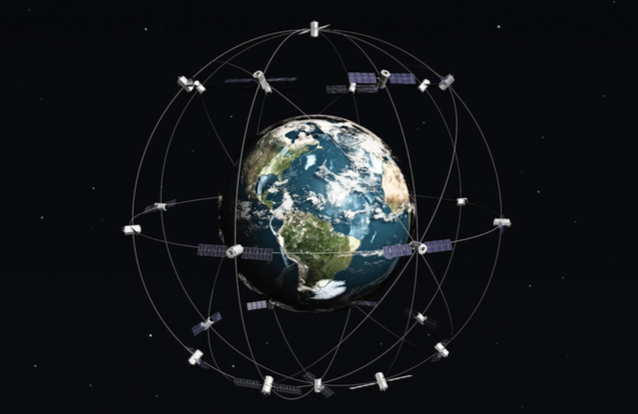In the previous post, “Why Ontologies“, we explored concepts at a very high level about what an ontology is, and how they can be used in AI, NLP, data integration, and knowledge management applications. So what does the picture of satellites orbiting the earth have to do with ontologies? In the previously mentioned post, we discussed how silos of information exist in almost every large organization. NASA had an analogous problem, and they solved it with the practical application of data management best practices, which included the use of domain specific ontologies[3].
Ontologies are not a panacea for all data related issues. However, any enterprise information architecture intended to enable horizontal communication between disparate data sources, with related and/or potentially different domains (e.g., banking and insurance), must identify a methodology for rapidly merging, and extracting Key Data Elements (KDE) necessary for answering essential competency questions[5]. The real differentiator for any organization today, whether it is NASA, the US military, or a Fortune 500 company, is their ability to rapidly integrate data and produce accurate and actionable insights. Acceptable performance measures for this level of agility is in units of seconds and minutes, not weeks, and months.
Supervised and unsupervised machine learning algorithms applied to well known, and understood data can rapidly detect failures and put corrective actions into motion before severe damage occurs. Better yet, identifying data outliers can prevent a failure from even occurring, or allow an organization to capitalize on rapidly changing conditions. Whether it is an engine overheating or gasses reaching a dangerous level as identified by sensor data, network intrusion detection identified by real time network log monitoring, or social and news media feeds indicating a need for risk reduction procedures to be implemented, the organization that can quickly identify risk and/or opportunity will have a distinct advantage over their competitors.
Seth Earley’s article below is excellent, and rather than trying to restate what he says, I will quote him directly:
“Correctly interpreting user signals enables the system to present the right content for the user’s context, and requires not only that our customer data is clean, properly structured, and integrated across multiple systems and processes but also that the system understand the relationship between the user, his or her specific task, the product, and the content needed—all assembled dynamically in real time. Building these structures and relationships and harmonizing the architecture across the various back-end platforms and front-end systems results in an enterprise ontology that enables a personalized, omnichannel experience. Some might call this an enterprise information architecture; however, there is more to it than the data structures. Recall that the definition of an ontology includes real-world logic and relationships. The ontology can contain knowledge about processes, customer needs, and content relationships.[4]”
Ontologies are a critical component of the enterprise information architecture. Organizations must be capable of rapidly gathering and interpreting data that provides them with insights, which in turn will give their organization an operational advantage. This is accomplished by developing ontologies that conceptualize the domain clearly, and allows transfer of knowledge between systems.
As described above, the practical application of ontologies range from NASA integrating data from multiple disparate systems that enables the rapid identification of system failures, to environmental monitoring for oil and gas operations through the Semantic Sensor Network (SSN)[1], to market volatility and risk management in the financial industry. to market volatility and risk management in the financial industry. These processes must have an acceptable level of performance measured in units of seconds and minutes. This requires the application of data management best practices, which culminates in an enterprise information architecture, of which ontologies are an essential component.
Unless you have an IEEE membership, a couple of my references require a purchase, and I apologize for that. Not all of the references listed below were directly referenced in this post. I provide them more as a recommended reading list for the topic. For the next post, using the free open source Protégé ontology editor and framework, we will load and modify a small ontology called “wines” which is the ontology discussed in the Ontology 101 paper listed in the references below[5].
-
Bou-Ghannam A., (2013) Foundational Ontologies for Smarter Industries. IBM Red Paper. Retrieved from: https://www.redbooks.ibm.com/Redbooks.nsf/RedbookAbstracts/redp5081…
-
Chandrasekaran B.,Josephson J.R., Benjamins V. R., (1999) What Are Ontologies, and Why Do We Need Them? IEEE Intelligent Systems Volume 14 Issue 1. Retrieved from: https://www.csee.umbc.edu/courses/771/papers/chandrasekaranetal99.pdf
-
Earley, S. (2016) Really, Really Big Data: NASA at the Forefront of Analytics, IEEE Computer Society Computing Edge, Retrieved from: http://doi.ieeecomputersociety.org/10.1109/MITP.2016.10
-
Earley, S. (2016) There is no AI without IA. IEEE Xplore IT Professional Vol: 18, Issue: 3. Retrieved from: http://ieeexplore.ieee.org/document/7478581/
-
Noy, N. F., & McGuinness, D. L. (2001). Ontology development 101: A guide to creating your first ontology. Retrieved from: http://protege.stanford.edu/publications/ontology_development/ontol…

